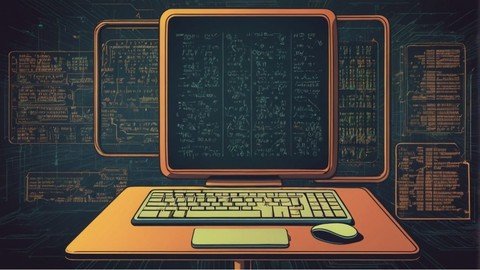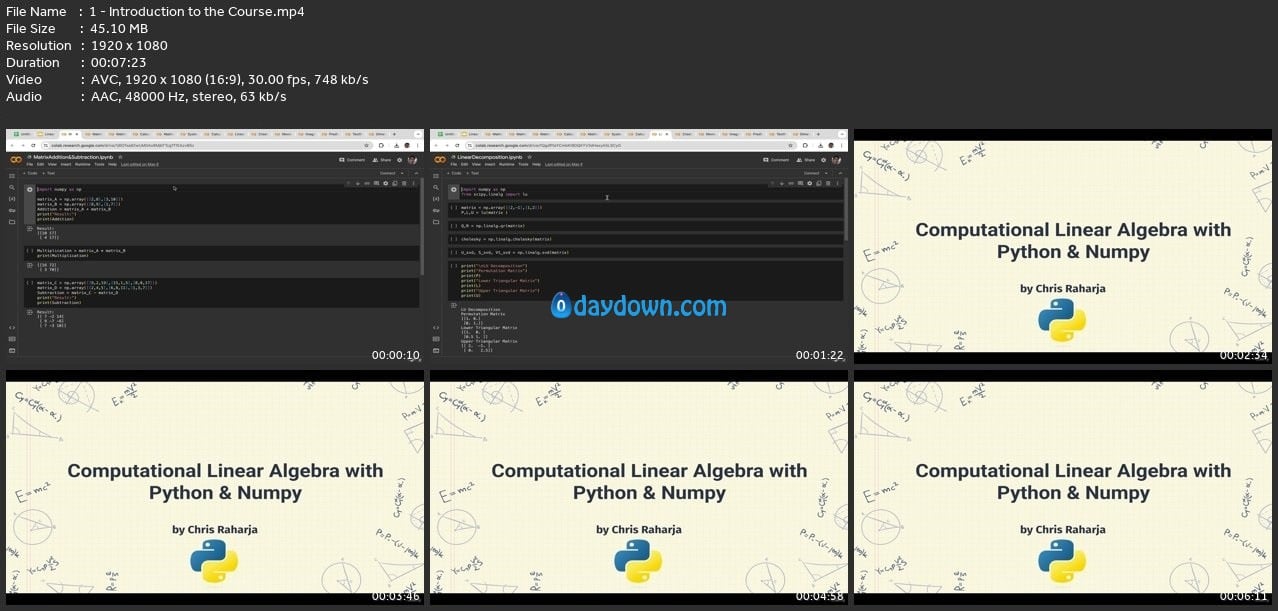
Published 5/2024
MP4 | Video: h264, 1920×1080 | Audio: AAC, 44.1 KHz
Language: English | Size: 1.27 GB | Duration: 3h 24m
Linear algebra computations using NumPy & SciPy, matrix operations, linear decomposition, principal component analysis
What you’ll learn
Learn the basic fundamentals of linear algebra, such as getting to know its real world applications and important key concepts
Learn about the difference between scalar, vector, matrix, and tensor
Learn how to add and subtract matrix using Numpy
Learn how to multiply matrix using Numpy
Learn how to inverse and transpose matrix using Numpy
Learn how to calculate matrix determinant using Numpy
Learn how to calculate matrix norm, trace, and rank using Numpy
Learn how to solve system of linear equation using Numpy
Learn how to calculate eigenvalues and eigenvectors using Numpy
Learn about LU, QR, and Cholesky decomposition
Learn how to create, slice, and reshape tensor using Numpy
Learn how to build movie recommendation engine using linear decomposition
Learn how to build image compressor using singular value decomposition
Learn how to predict real estate market using linear regression
Learn how to do text mining using non negative matrix factorization
Learn how to perform dimensionality reduction using principal component analysis
Requirements
No previous experience in linear algebra is required
Basic knowledge in Python and Numpy
Description
Welcome to Computational Linear Algebra with Python & Numpy course. This is a comprehensive linear algebra tutorial for data scientists and machine learning engineers, this course will cover fundamental concepts, practical implementations, and real-world applications to enhance your understanding and expertise in the field. This course is a perfect combination between linear algebra and python, making it an ideal opportunity for anyone who is looking to practice their programming skills while improving their mathematical knowledge. In the introduction session, you will learn the basic fundamentals of linear algebra, such as getting to know its use cases and key concepts. Then, in the next section, we will start the first lesson where you will get to know more about the basic concepts like scalar, vector, and matrices. In addition, you will also learn about matrix operations like addition, subtraction, two by two matrix multiplications, and three by three matrix multiplications. Afterward, in the second lesson, you will learn how to perform inverse and transpose on matrices manually, then after that you will also learn how to use Numpy to do the calculation. In the third lesson, you will learn how to calculate determinants of two by two matrices and three by three matrices both manually and using Numpy. Then, in the fourth lesson, you will learn how to solve complex linear equations and to make sure you understand the concepts, we will try many practice problems. Meanwhile, in the fifth lesson, you will learn how to calculate eigenvalues and eigenvectors both manually and using Numpy. Then, in the sixth lesson, you will learn about linear decomposition particularly LU, QR, and Cholesky decomposition. Firstly we will do the calculation manually then after you understand the basic concepts, then we will utilize Numpy for computations. After that, in the seventh lesson, you will learn how to create a tensor with specific size using Numpy and even more exciting, we will play around with the tensors and learn how to access a value of tensor by using slicing and indexing techniques. Then, in the eighth lesson, you will learn how to calculate singular value decomposition both manually and also using Numpy. After we are done with linear algebra lessons, we will make sure that you have the opportunity to implement all concepts that you have learnt into real world projects. In total, there will be five projects, in the first project, you will build recommendation engine using linear decomposition, in the second project, you will build image compressor using singular value decomposition, in the third project, you will predict real estate market using linear regression, in the fourth project, you will do text mining using non negative matrix factorization, and in the last project, you will perform dimensionality reduction using principal component analysis.First of all, before getting into the course, we need to ask ourselves this question, why should we learn about computational linear algebra? Well, here is my answer. Linear algebra serves as the foundation for many advanced mathematical concepts and techniques used in machine learning, data science, and engineering. In machine learning, linear algebra is essential for understanding and implementing algorithms such as linear regression, support vector machines, and neural networks. In data science, linear algebra enables us to analyze large datasets efficiently, perform dimensionality reduction, and solve optimization problems. In engineering, linear algebra plays a critical role in modeling physical systems, designing control systems, and solving differential equations.Below are things that you can expect to learn from this course:Learn the basic fundamentals of linear algebra, such as getting to know its real world applications and important key conceptsLearn about the difference between scalar, vector, matrix, and tensorLearn how to add and subtract matrix using NumpyLearn how to multiply matrix using NumpyLearn how to inverse and transpose matrix using NumpyLearn how to calculate matrix determinant using NumpyLearn how to calculate matrix norm, trace, and rank using NumpyLearn how to solve system of linear equation using NumpyLearn how to calculate eigenvalues and eigenvectors using NumpyLearn about LU, QR, and Cholesky decompositionLearn how to create, slice, and reshape tensor using NumpyLearn how to build movie recommendation engine using linear decompositionLearn how to build image compressor using singular value decompositionLearn how to predict real estate market using linear regressionLearn how to do text mining using non negative matrix factorizationLearn how to perform dimensionality reduction using principal component analysis
Overview
Section 1: Introduction
Lecture 1 Introduction to the Course
Lecture 2 Table of Contents
Lecture 3 Whom This Course is Intended for?
Section 2: Tools & Resources
Lecture 4 Tools & Resources
Section 3: Introduction to Linear Algebra
Lecture 5 Introduction to Linear Algebra
Section 4: Scalar, Vector, Matrix, and Tensor
Lecture 6 Scalar, Vector, Matrix, and Tensor
Section 5: Matrix Addition & Subtraction with Numpy
Lecture 7 Matrix Addition & Subtraction with Numpy
Section 6: Matrix Multiplications with Numpy
Lecture 8 Matrix Multiplications with Numpy
Section 7: Matrix Inverse & Transpose with Numpy
Lecture 9 Matrix Inverse & Transpose with Numpy
Section 8: Calculating Matrix Determinant with Numpy
Lecture 10 Calculating Matrix Determinant with Numpy
Section 9: Calculating Matrix Norm, Trace, and Rank with Numpy
Lecture 11 Calculating Matrix Norm, Trace, and Rank with Numpy
Section 10: Solving System of Linear Equation Using Numpy
Lecture 12 Solving System of Linear Equation Using Numpy
Section 11: Calculating Eigenvalues & Eigenvectors with Numpy
Lecture 13 Calculating Eigenvalues & Eigenvectors with Numpy
Section 12: LU, QR, and Cholesky Decomposition
Lecture 14 LU, QR, and Cholesky Decomposition
Section 13: Creating Tensor with Numpy
Lecture 15 Creating Tensor with Numpy
Section 14: Building Movie Recommendation Engine Using Linear Decomposition
Lecture 16 Building Movie Recommendation Engine Using Linear Decomposition
Section 15: Compressing Image Using Singular Value Decomposition
Lecture 17 Compressing Image Using Singular Value Decomposition
Section 16: Predicting Real Estate Market Using Linear Regression
Lecture 18 Predicting Real Estate Market Using Linear Regression
Section 17: Text Mining Using Non Negative Matrix Factorization
Lecture 19 Text Mining Using Non Negative Matrix Factorization
Section 18: Performing Dimensionality Reduction Using Principle Component Analysis
Lecture 20 Performing Dimensionality Reduction Using Principle Component Analysis
Section 19: Conclusion & Summary
Lecture 21 Conclusion & Summary
People who are interested in learning about linear algebra and its real world applications,People who are interested in data science and machine learning
转载请注明:0daytown » Computational Linear Algebra With Python & Numpy
 Password/解压密码www.tbtos.com
Password/解压密码www.tbtos.com